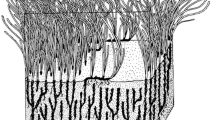Abstract
The 1930's wasting disease among the North Atlantic population of eelgrass,Zostera marina, is still an ecological and historical enigma, despite several attractive theories. Van der Werff investigated the die-back of eelgrass in the thirties in the Dutch Wadden Sea, and he considered the micro-organismLabyrinthula as the possible cause of the disease. In 1980, Grevelingen lagoon, harbouring an extensive population ofZostera marina, experienced a major decline of the area covered by the submerged macrophyte. Speculations about the cause of this dramatic decline induced us to think that the wasting disease had struck again. Van der Werff investigated the Grevelingen population and found bothLabyrinthula and a Chaetophoracean endophytic alga to be presumably responsible for the decline. During the quest for the ultimate cause of the wasting disease the question remains whether both micro-organisms are the cause of the disease or simply an effect of decomposition processes triggered by other factors.
Similar content being viewed by others
References
DEN HARTOG, C., 1987. ‘Wasting disease’ and other dynamic phenomena inZostera-beds. Aquat. Bot., 27: 3–14.
DEN HARTOG, C., 1989. Early records of wasting-disease-like damage patterns in eelgrassZostera marina. Dis. aquat. Org., 7: 223–226.
DEN HARTOG, C., 1994. The dieback ofZostera marina in the 1930's in the Waddensea: an eye-witness account by A. van der Werff. Neth. J. Aquat. Ecol., 28: 51–54.
FISCHER-PIETTE, E., R. HEIM and R. LAMI, 1932. Note préliminaire sur une maladie bactérienne des Zostères. Comples rendues des séances de l'Académie des Sciences, 195: 1420–1422.
FRITSCH, F.E., 1965. The structure and reproduction of the algae, Volume I. University Press, Cambridge, p. 1–791.
GIESEN, W.B.J.T., M. VAN KATWIJK and C. DEN HARTOG, 1990. Temperature, salinity, insolation and wasting disease of eelgrass (Zostera marina L.) in the Dutch Wadden Sea in the 1930's. Neth. J. Sea Res., 25: 395–404.
HARMSEN, G.W., 1936. Systematische Beobachtungen der Nordwest Europäischen Seegrasformen. Nederl. Kruidkund. Archief, 46: 852–877.
HEIM, R. and R. LAMI, 1933. La maladie bactérienne des Zostères: extension et causes favorisantes. Acad. Agricult. France. Procès Verbaux, 14-6-1933: 1–5.
LEPSI, I., 1965. Protozoologie. Edit. Acad. Republ. Social. Romania.
MUEHLSTEIN, L.K., D. PORTER and F.T. SHORT, 1988.Labyrinthula sp., a marine slime mold producing the symptoms of wasting disease in eelgrass,Zostera marina. Mar. Biol., 99: 465–472.
NIENHUIS, P.H., 1983. Temporal and spatial patterns of eelgrass (Zostera marina L.) in a former estuary in the Netherlands, dominated by human activities. Mar. Techn. Soc. J., 17: 69–77.
RENN, Ch. E., 1934. Wasting disease ofZostera in American waters. Nature, 134: 416.
RENN, Ch. E., 1935. A mycetozoan parasite ofZostera marina. Nature, 135: 544–545.
RENN, Ch. E., 1936. The wasting disease ofZostera marina: I. A phytological investigation of the diseased plant. Biol. Bull. 70: 148–158.
RENN, Ch. E., 1937. The eelgrass situation along the middle Atlantic coast. Ecology, 18: 323–325.
SHORT, F.T., A.C. MATHIESON, and J.I. NELSON, 1986. Recurrence of the eelgrass wasting disease at the border of New Hampshire and Maine, USA. Mar. Ecol. Progr. Ser., 29: 89–92.
SHORT, F.T., L.K. MUEHLSTEIN, and D. PORTER, 1987. Eelgrass wasting disease: cause and recurrence of a marine epidemic. Biol. Bull., 173: 557–562.
SHORT, F.T., B.W. IBELINGS and C. DEN HARTOG, 1988. Comparison of a current eelgrass disease to the wasting disease in the 1930's. Aquat. Bot., 30: 295–304.
SPIERENBURG, D., 1933. Een ziekte in het zeegras (Zostera marina L.). Tijdschr. over Plantenz., 39: 193–199.
STEVENS, N.E., 1936. Environmental conditions and the wasting disease of eel-grass. Science, 84: 87–89.
VAN DER WERFF, A., 1936. Over een tot dusver onbekend organisme inZostera marina L. Published in 1961 in Bulletin Zuiderzeemuseum, Enkhuizen.
VAN DER WERFF, A., 1938. A new parasitic organism inZostera marina. Chronica Botanica, 4: 488–499.
YOUNG, E.L. III. 1937. Notes on theLabyrinthula parasite of the eel-grassZostera marina. Bull. Mt. Desert Isl. Biol. Lab.
YOUNG, E.L. III, 1943. Studies ofLabyrinthula. The etiologic agent of the wasting disease of eel-grass. Amer. J. Bot., 30: 586–593.
Author information
Authors and Affiliations
Rights and permissions
About this article
Cite this article
Nienhuis, P.H. Causes of the eelgrass wasting disease: Van der Werff's changing theories. Netherlands Journal of Aquatic Ecology 28, 55–61 (1994). https://doi.org/10.1007/BF02334245
Issue Date:
DOI: https://doi.org/10.1007/BF02334245




